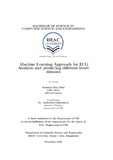| dc.contributor.advisor | Chakrabarty, Amitabha | |
| dc.contributor.author | Tithi, Sushmita Roy | |
| dc.contributor.author | Aktar, Afifa | |
| dc.contributor.author | Aleem, Fahimul | |
| dc.date.accessioned | 2019-02-13T07:15:28Z | |
| dc.date.available | 2019-02-13T07:15:28Z | |
| dc.date.copyright | 2018 | |
| dc.date.issued | 2018-12 | |
| dc.identifier.other | ID 14201051 | |
| dc.identifier.other | ID 15101015 | |
| dc.identifier.other | ID 15101126 | |
| dc.identifier.uri | http://hdl.handle.net/10361/11409 | |
| dc.description | This thesis is submitted in partial fulfilment of the requirements for the degree of Bachelor of Science in Computer Science and Engineering, 2018. | en_US |
| dc.description | Includes bibliographical references (pages 54-57). | |
| dc.description | Cataloged from PDF version of thesis. | |
| dc.description.abstract | In the modern world, there have been some revolutionary advancement in the field of medical
science and research and this is no different for electrocardiogram. Electrocardiogram (also
abbreviated as ECG) illustrates the electrical activity of one’s heart over a period of time.
Over the years, number of people suffering from heart disease have increased to some extent.
Therefore, in our research, we aim to design a model using supervised machine learning that
can find anomalies in one’s ECG report by analyzing it. We have applied six supervised
machine learning algorithms to distinguish between normal and abnormal ECG. In addition,
we used them to predict the chances of a patient suffering from a certain disease. We divided
our data set into two parts. 75 percent data in one group for training the model and rest
25 percent data in another group for testing. To avoid any kind of anomalies or repetitions,
Cross Validation and Random Train-Test Split was used to obtain an answer as accurate as
possible. We have compared the results with each other for a better understanding. | en_US |
| dc.description.statementofresponsibility | Sushmita Roy Tithi | |
| dc.description.statementofresponsibility | Afifa Aktar | |
| dc.description.statementofresponsibility | Fahimul Aleem | |
| dc.format.extent | 57 pages | |
| dc.language.iso | en | en_US |
| dc.publisher | BRAC University | en_US |
| dc.rights | BRAC University theses are protected by copyright. They may be viewed from this source for any purpose, but reproduction or distribution in any format is prohibited without written permission. | |
| dc.subject | Machine learning | en_US |
| dc.subject | ECG | en_US |
| dc.subject | Heart diseases | en_US |
| dc.subject.lcsh | Diseases -- Early detection. | |
| dc.subject.lcsh | Medical informatics. | |
| dc.subject.lcsh | Artificial intelligence. | |
| dc.subject.lcsh | Machine learning. | |
| dc.title | Machine learning approach for ECG analysis and predicting different heart diseases | en_US |
| dc.type | Thesis | en_US |
| dc.contributor.department | Department of Computer Science and Engineering, BRAC University | |
| dc.description.degree | B. Computer Science and Engineering | |

